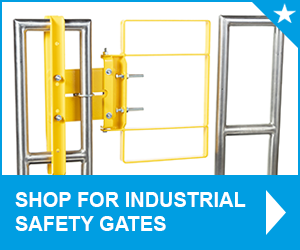
To maximize the productive areas within your industry facility you’ve likely taken advantage of the vertical space inside your building. The most common way for employees to travel from level to level is usually a staircase or stairwell. But just because it’s common, doesn’t mean it doesn’t present a series of safety concerns. To keep employees safe from falls while they traverse these stairs, it’s important to focus on dependable, OSHA compliant stairwell fall protection. From proper tread spacing, adequate handrails, a safety rail system to stairwell gates to restrict access, we’ll answer some frequently asked questions about stairwell fall protection requirements here.
What Are the Fall Hazards Associated with Stairwells?
Although stairs are a fast, effective way for workers to get from one level to the next, stairwells in any commercial or industrial setting can be dangerous. Workers face a variety of trip, slip, and fall hazards whenever they must use stairs. Common fall hazards on stairs and around stairwells include:
- Objects on the stairs
- Dim stairwell lighting
- Slippery conditions
- Treads and risers that aren’t properly proportioned
- Inattentive, rushed workers
When Does OSHA Require Fall Protection on Stairways?
Walking up and down stairs seems like a basic activity that doesn’t require much thought or safety equipment. However, stairwells can be extremely dangerous for workers, especially if they’re distracted. Per OSHA 1910.52:
- Stairways with four or more risers and a height of 30″ or more must have both a handrail and guardrail.
- Stairs are required to be installed at 30° to 50° from horizontal.
- Stair height and the depth of treads must be uniform.
- There must be a minimum of 6′ 8″ of vertical clearance above the stairs.
- Each step must be able to handle 5x the intended load.
What Are the OSHA Requirements for Stairway Fall Protection?
OSHA takes fall protection seriously and stairwell entrances are one of the areas of focus during inspections. Per OSHA 1910.28, employees exposed to an unprotected side or edge of a stairway landing that is 4 feet (1.2 m) or more above a lower level must be protected by a guardrail or stair rail system and an adjustable safety gate, or other fall safety system.
What Are the OSHA Requirements for Guardrails for Stairways?
When a stairway has a landing that requires fall protection, you might consider installing a guardrail system to protect workers using the stairwell. It’s important to follow the guidelines in OSHA 1910.29(b) whenever you’re using guardrails to ensure they meet the minimum requirements:
- The top rails of guardrails must be 42″ (give or take 3″) from the surface below.
- Top rails must be capable of handling 200 lbs. of downward or outward force without failing.
- Mid-rails must withstand a force of 150 lbs. of downward or outward force.
- Guardrails must be constructed of smooth material that will not scratch or snag workers.
Is a Self-Closing Safety Gate for a Stairwell an OSHA Requirement?
It’s rare for OSHA to state that you must use a specific fall protection device. While a self-closing safety gate at the entrance of a stairwell is an excellent way to protect workers, OSHA does not have a specific requirement for this placement of equipment.
What Does OSHA Require for Stairwell Gates?
An indoor safety gate installed along with a metal guardrail provides additional fall protection at the entrance to stairwells. Stairwell gates can also keep unauthorized personnel out of certain areas. Per OSHA 1910.29 your indoor safety gates must meet the following criteria:
- Your indoor stairway gate must be the same size, strength, and materials as your guardrail system.
- The stairwell gate must slide or swing away from the stairway entrance,
- A stairway gate should be self-closing to allow for hands-free entry.
Do I Need to Install Handrails in My Stairwells?
Absolutely. In addition to a guardrail system and adjustable safety gate, handrails are an OSHA fall protection requirement. For stairways that have at least 3 treads and 4 risers, you will also need to install handrails for workers to hold as they ascend and descend the stairs.
What Are the OSHA Requirements for Stairwell Handrails?
OSHA handrail requirements depend upon the size of the stairway:
- Stairways less than 44 inches (1.1 m) wide require at least one handrail.
- Stairways 44 inches (1.1 m) to 88 inches (2.2 m) wide require a handrail on each enclosed side.
- When stairs are greater than 88 inches (2.2 m), one handrail on each enclosed side and one intermediate handrail located in the middle of the stair is required to meet OSHA standards.
How Do I Choose the Right Stairway Fall Protection?
It’s vital to your employees’ safety that you install proper fall protection equipment throughout your industrial facility. It’s also extremely important that your company meets OSHA guidelines for workplace safety. To ensure your facility is safe and compliant, perform an inspection alongside a qualified safety expert. Once you’ve identified fall hazards you wish to address, it’s time to decide what fall protection will work best for your situation. For most applications, that’s going to mean a guardrail and indoor safety gate. You also have to remember that you must remain in compliance with OSHA regulations to avoid fines and penalties.
OSHA-Compliant Fall Protection and Equipment from Fabenco
Not sure about what types of fall protection you need for your facility’s stairways? Choosing fall safety equipment can be a daunting task, but our stairway fall protection experts are here to help. We’ll work with you to ensure your company is compliant and your employees are safe on the job. Contact the fall protection specialists at Fabenco for expert advice on a wide variety of indoor safety gates, guardrail systems, and other fall protection equipment.





